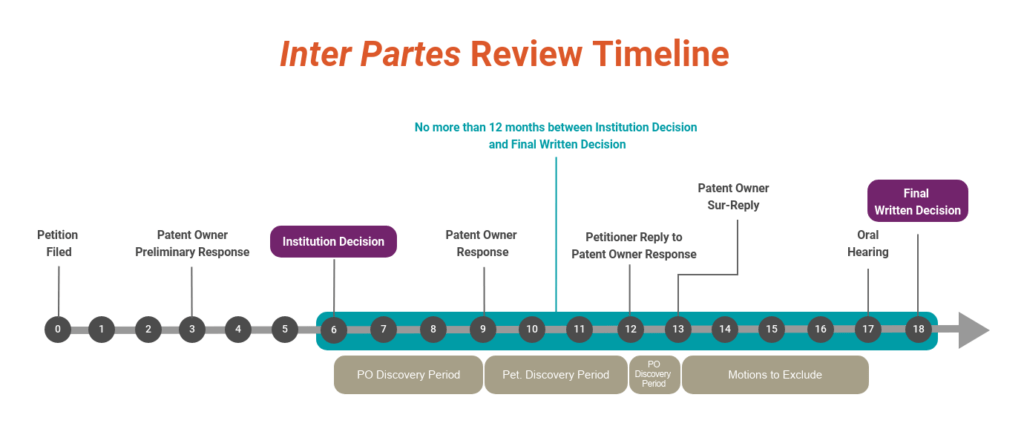IP Law Essentials
What Discovery is Available during Inter Partes Review?
Authors
-
- Name
- Person title
- Principal

Litigants facing their first inter partes review ("IPR") before the Patent Trial and Appeal Board ("PTAB") may be surprised to learn that discovery timing, procedures, and scope are quite different compared to district court litigation under the Federal Rules of Civil Procedure ("FRCP"). Discovery in an IPR is governed by the rules[1] and Trial Practice Guide[2] promulgated by the U.S. Patent and Trademark Office ("PTO"). The relatively limited discovery permitted for IPR proceedings helps to keep the proceedings narrowly focused and on track to complete within the statutory one-year period. Three forms of discovery are available under the rules: mandatory initial disclosures, routine discovery, and additional discovery.
What is the discovery timeline?
If the PTAB institutes review, it will concurrently release a Scheduling Order that lays out the discovery timeline. In contrast to civil litigation under the FRCP, discovery in an IPR proceeds in a sequenced fashion. Typically, the patent owner will first get a three-month discovery window to develop and file its response and motion to amend claims, after which the petitioner will have its own three-month discovery window to develop and file its reply and opposition to any amendments. The patent owner may then get another one month to conduct discovery to respond to the petitioner's opposition. After discovery has closed, both the patent owner and petitioner may file motions to exclude evidence they believe to be inadmissible under the Federal Rules of Evidence.

Timeline of key events (including discovery) in an IPR Proceeding
What are the mandatory initial disclosures?
Parties may either agree to initial disclosures or the PTAB may order them on motion. Despite their name, mandatory initial disclosures are actually optional under the PTAB rules. If the parties agree to initial disclosures, the PTAB offers two options. The first option is modeled after FRCP Rule 26(a)(1)(A) and includes the name and contact information of persons and all documents that the disclosing party possess that the party may use to support their claims or defenses. The second option is much more extensive and includes substantial information on alleged prior non-published public disclosures (relevant to Post-Grant Review ("PGR") proceedings in which claims can be challenged based on prior public use) and information regarding secondary indicia of non-obviousness.
Is routine discovery permitted?
PTAB authorization is not required to conduct routine discovery, though the PTAB will set the relevant deadlines in the Scheduling Order. Routine discovery includes the production of any exhibit cited in a paper or testimony, the cross-examination of the other party's declarant or affiant, and relevant information that is inconsistent with a position advanced during the proceeding. Exhibits must be produced at the same time the paper or testimony in which they are cited is served. Note that this does not apply to documents relied upon when preparing the paper or testimony, only those documents that are actually cited. For cross-examination, the burden and expense of producing a witness ordinarily falls on the party presenting the witness, while the taking party ordinarily pays the costs associated with the deposition.
What sort of additional discovery is permitted?
Additional discovery is rarely granted unless agreed to by the parties. Without an agreement, a party must move for additional discovery, which the PTAB will only grant if it is in the interests of justice. The PTAB analyzes this standard under five factors:
- whether there is more than a mere possibility or mere allegation that useful information will be produced;
- whether the party is inappropriately requesting the other party's litigation position and its underlying bases;
- whether the moving party has the ability to generate equivalent information by other means;
- whether the requests are easily understandable; and
- whether the requests are overly burdensome to answer
The most likely, though nevertheless infrequent, areas where the PTAB will grant additional discovery are for identifying the real parties-in-interest and seeking evidence of objective indicia of non-obviousness.
Takeaways:
The administrative proceedings of an IPR are streamlined as compared to district court litigation in numerous respects, including discovery. Discovery during an IPR is sequential, abbreviated, and generally conducted without the intervention of the PTAB. Unaccustomed litigants who find themselves in front of the PTAB should preemptively familiarize themselves with the rules and Trial Practice Guide set out by the PTO.
More questions? Contact the authors or visitFish's Intellectual Property Law Essentials.
[1] 37 C.F.R. 42.51.
[2] https://www.uspto.gov/sites/default/files/documents/tpgnov.pdf?MURL=.
Authors: Rick Bisenius, Dan Smith, and Ryan Petty
The opinions expressed are those of the authors on the date noted above and do not necessarily reflect the views of Fish & Richardson P.C., any other of its lawyers, its clients, or any of its or their respective affiliates. This post is for general information purposes only and is not intended to be and should not be taken as legal advice. No attorney-client relationship is formed.